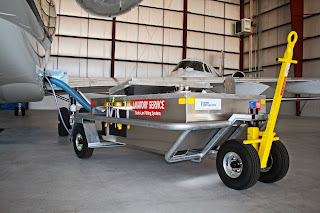Eliminating Common Pain Points for Airside Ground Crews
Being a member of an airside ground crew is already stressful enough. On top of the high-dollar, high-stress, fast-moving, and physically demanding nature of the work, it’s a dangerous place to be. They’re working in and around aircraft pushback tugs, tow tractors, baggage carts, and the other ground support equipment (GSE) in operation, not to mention the massive airliners. The last thing someone in a such a sensitive workplace needs is the addition of extra pain points, or an avoidable failure.
Communication Within a Ground Crew
Communication is likely the most effective way for a work crew to improve the safety and efficiency of their operations. In addition to the general communication protocols between operators of GSE, the ground operations manager, and anyone else pertinent, specific training for communication during stressful events or emergencies is extremely important. Incorporating communication-enhancing technology can also make a big difference. That technology includes anything from noise-canceling headsets to fleet-linking telematics systems.
Communication with Other Crews and Flight Staff
Even among ground crews that feature excellent intra-squad communication, real problems can crop up if the same communication standards don’t apply outside the crew. Setting up open lines of communication with other airlines’ crews, if they haven’t been (well) established, should include clear protocols describing how to get in touch, and who with, for each crew. A miscommunication or oversight resulting in one crew’s aircraft tug blocking another’s path or access can result in delays, major inconveniences, and lots of money lost. The importance and effectiveness of inter-crew communication and cooperation certainly aren’t being overlooked in the industry. In fact, it’s practically illustrated by the increasingly popular trend of GSE pooling and similarly cooperative initiatives.
Technological Innovations Contributing to Safety and Efficiency
Technology can prove one of the most effective ways to promote safety and ensure efficiency. The earlier-mentioned telematics systems link up entire fleets, provide real-time data on their location, their use status, and even their maintenance status. Being familiar with the location and status of every piece of GSE in a fleet can prove invaluable. More specific innovations, a good example being the SiPsHitch™ Linear Force Monitoring System from GSE manufacturer AERO Specialties, can make ground crew life far easier as well. The SiPsHitch™ system tracks and records the stress being applied to the nose gear of aircraft while being towed, warning operators of potential overstress in time to prevent damage. A mixture of solid technology and effective training can address a large number of pain points.
About AERO Specialties
AERO Specialties is among the most trusted, respected, reliable ground support equipment (GSE) manufacturers and distributors in the world. Employing leading-edge technological innovation and the most stringent manufacturing standards means their GSE can optimize the operations of any airport orFixed Base Operator (FBO). To better serve their customers, AERO Specialties ensures that every member of their staff, from the mechanics to the sales team and customer service, is entirely familiar with the GSE and its operation. In short, AERO Specialties has everything your aviation business needs, be it a high-performance aircraft ground power unit or their innovative SiPsHitch™ Linear Force Monitoring System.
Partner with AERO Specialties to take your aviation business to the stratosphere and beyond, at Aerospecialties.com
Communication Within a Ground Crew
Communication is likely the most effective way for a work crew to improve the safety and efficiency of their operations. In addition to the general communication protocols between operators of GSE, the ground operations manager, and anyone else pertinent, specific training for communication during stressful events or emergencies is extremely important. Incorporating communication-enhancing technology can also make a big difference. That technology includes anything from noise-canceling headsets to fleet-linking telematics systems.
Communication with Other Crews and Flight Staff
Even among ground crews that feature excellent intra-squad communication, real problems can crop up if the same communication standards don’t apply outside the crew. Setting up open lines of communication with other airlines’ crews, if they haven’t been (well) established, should include clear protocols describing how to get in touch, and who with, for each crew. A miscommunication or oversight resulting in one crew’s aircraft tug blocking another’s path or access can result in delays, major inconveniences, and lots of money lost. The importance and effectiveness of inter-crew communication and cooperation certainly aren’t being overlooked in the industry. In fact, it’s practically illustrated by the increasingly popular trend of GSE pooling and similarly cooperative initiatives.
Technological Innovations Contributing to Safety and Efficiency
Technology can prove one of the most effective ways to promote safety and ensure efficiency. The earlier-mentioned telematics systems link up entire fleets, provide real-time data on their location, their use status, and even their maintenance status. Being familiar with the location and status of every piece of GSE in a fleet can prove invaluable. More specific innovations, a good example being the SiPsHitch™ Linear Force Monitoring System from GSE manufacturer AERO Specialties, can make ground crew life far easier as well. The SiPsHitch™ system tracks and records the stress being applied to the nose gear of aircraft while being towed, warning operators of potential overstress in time to prevent damage. A mixture of solid technology and effective training can address a large number of pain points.
About AERO Specialties
AERO Specialties is among the most trusted, respected, reliable ground support equipment (GSE) manufacturers and distributors in the world. Employing leading-edge technological innovation and the most stringent manufacturing standards means their GSE can optimize the operations of any airport orFixed Base Operator (FBO). To better serve their customers, AERO Specialties ensures that every member of their staff, from the mechanics to the sales team and customer service, is entirely familiar with the GSE and its operation. In short, AERO Specialties has everything your aviation business needs, be it a high-performance aircraft ground power unit or their innovative SiPsHitch™ Linear Force Monitoring System.
Partner with AERO Specialties to take your aviation business to the stratosphere and beyond, at Aerospecialties.com




Comments
Post a Comment